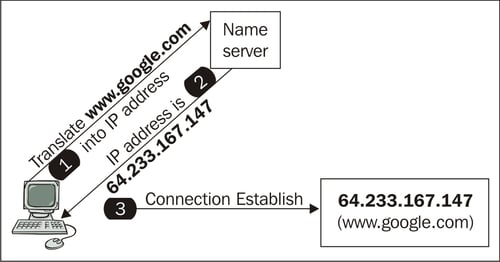All applications that provide communication between computers on the Internet use IP addresses to identify communicating hosts. However, IP addresses are difficult for human users to remember. That is why we use the name of a network interface instead of an IP address. For each IP address, there is a name of a network interface (computer)—or to be exact, a domain name. This domain name can be used in all commands where it is possible to use an IP address. (One exception, where only an IP address can be used, is the specification of an actual name server.) A single IP address can have several domain names affiliated with it.
The relationship between the name of a computer and an IP address is defined in the Domain Name System (DNS) database. The DNS database is distributed worldwide. The DNS database contains individual records that are called Resource Records (RR). Individual parts of the DNS database called zones are placed on particular name servers. DNS is a worldwide distributed database.
If you want to use an Internet browser to browse to www.google.com with the IP address 64.233.167.147 (Figure 1.1), you enter the website name www.google.com in the browser address field.

Figure 1.1: It is necessary to translate a name to an IP address before establishing a connection
Just before the connection with the www.google.com web server is made, the www.google.com DNS name is translated into an IP address and only then is the connection actually established.
It is practical to use an IP address instead of a domain name whenever we suspect that the DNS on the computer is not working correctly. Although it seems unusual, in this case, we can write something like:
ping 64.233.167.147 http://64.233.167.147
or send email to
dostalek@[64.233.167.147]
However, the reaction can be unexpected, especially for the email, HTTP, and HTTPS protocols. Mail servers do not necessarily support transport to servers listed in brackets. HTTP will return to us the primary home page, and the HTTPS protocol will complain that the server name does not match the server name in the server’s certificate.



